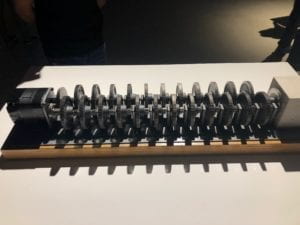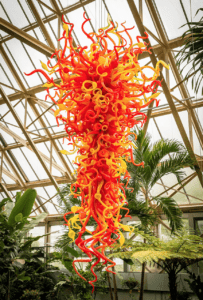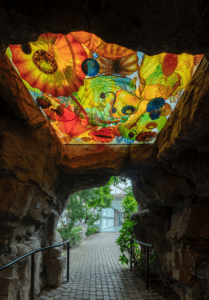After having visited the Cronus Art Center and exploring the exhibition there I am feeling particularly inspired by all of the creative and innovative ways to integrate technology into art and design. Not only were there many fascinating pieces to observe here, but also I find it interesting to think about the ways in which technology can add an extra element or layer to more traditional art works. This can be exceptionally relevant when the artists are trying to make a statement that might not be familiar to some viewers. One work that stood out to me as demonstrating a compelling use of technology was the “Beholding the Big Bang” piece made of motors, gears, and a concrete block. While only a few of the gears in this sculpture appeared to be moving, this work is making a mind boggling statement about the passage of time. What I find relevant about this integration of technology, movement, and motors into art is the message this is sending about the relative brevity of the things we create and their capacity to withstand the test of time. Because it will take the final gear 13.82 billion years to ever turn, it is clear that it will in fact never happen. However, the premise of this design and concept sheds further light on the purpose of art itself, and how we are able to appreciate such a complex machine even if we can never experience the final turn. Rather we are left forced to come to terms with the nature of time and instead appreciate the beauty in visualizing this interesting (although frustrating) idea.

Much of the art that I have had the pleasure of experiencing in the past, although being incredible, did not necessarily incorporate technology or interactivity into the overall concept. After having seen this exhibit I am very excited about the idea of learning to bring together these elements to send an even more relevant and interesting message to my audiences. Even when the objective of the piece is not 100% clear to viewers, it is evident that art that makes use of technology is capable of creating new perspectives on topics we thought we already understood.
One interactive artistic experience I have had in the past and that inspires me for this project was at the Franklin Park Conservatory in Columbus, Ohio. The artist, Dale Chihuly has created gigantic, colorful, and magnificent glass sculptures that are integrated into a botanical garden. After both visiting this site and further researching the artist and the conservatory, it is evident that not only are the art works stunning in their size and their integration into nature and their surroundings, but also it allows visitors to fully put themselves into this atmosphere of both the natural and the artistic world. What stands out to me as particularly interactive about this exhibit are the active and living elements of the experience.


Although this art exhibit does not necessarily make use of technology in its design structure, it certainly demonstrates an interesting level of interaction, as it is filled with live, energetic butterflies. This combination of striking, colorful glass structures, an abundance of natural plants, and countless fluttering butterflies create an experience unlike any other for visitors. By adding these beautiful animals to the garden, the artists and designers have created an exhibit where much of the fun comes from the ability to interact with playful butterflies and watch as they fly around the space and then land someplace interesting. To me this is a very successful way to make use of interaction in that it draws attention to moving ourselves throughout the exhibit and following the butterflies to watch their response. Even though this is not something I could recreate, as I do not plan to involve butterflies into my project, I think there are many inspiring aspects to this exhibit. I am also interested to think of the ways in which technology could be used to mimic the movements of these animals and still create an interactive experience for visitors. Another concern is regarding the safety of the butterflies, as allowing for the public to enter these spaces is also potentially putting them at risk for people harming them in some way. On balance, however, I feel this form of art and interaction is very successful in creating a beautiful, active, and unique experience.
Next I researched for various other specifically interactive art exhibits that make use of technology and found this very interesting museum for children and the “Painting with Light” exhibit. This incorporation of science and art into something really fun and beautiful for children to use inspiring to me because it is both intuitive but also brand new in its conception and execution. I also really like this idea because it allows for the audiences to create something themselves, which I find to always be worthwhile, as it presents unlimited potential outcomes and products.
https://creativemachines.com/portfolio/painting-with-light
I feel that this artistic site demonstrates a compelling relationship to interaction because it is giving its users (specifically children) a new tool to be able to express their individual ideas and the desire to be creative. Because I really enjoy working with kids, I find this approach to making something that is both interactive and artistic to be really fascinating because it presents an opportunity to work with really young people that are frequently far more eager to jump right into trying something new and experimenting with creative elements. For this reason and the inspired goal of using light to make paintings, I see this piece as being quite successful as well.
As my own definition of interaction has developed over the course of the semester, I feel that in order for an interactive experience to be successful it must first consist of intrigue. Intrigue (in any form– possibly cuteness, interesting design, complexity in appearance) is necessary as something must initially draw the viewers into the piece for any interaction to take place. After this first catch, interaction must consist of the translating of communication from either the audience to the device or vice versa. This communication in-between the various parties is critical in that it interprets the input to then generate a new response. In my opinion, this new response is finally what is critical in order to have successful interaction in that a new result, experience, or creative output is truly the goal of an level of interaction. As evidenced by the Chihuly exhibit with the butterflies, this experience was definitely successful interaction because incorporating butterflies into the art is an incredibly fun way to get people involved with each other and their surroundings. I found it impossible not to follow the colorful wings from one sculpture to another and then try and hold as still as possible when one landed on my face. Then when the butterfly was comfortable enough to interact with me on this level, I had to take pictures to share the experience. This interaction with animals and art could not have been more exciting and dynamic. As my working definition of interaction applies to the second exhibit I researched, it is clear that this is successful in that it presents kids with a very new and different opportunity to create something for themselves. In this way, audiences get to interact with the artwork in that they are putting themselves in the position of artist and are interacting with this technology to make new designs. Ultimately, interaction allows audiences to have experiences with art forms that they may have never previously encountered and to consider the importance of movement, action, and thought when it comes to art and design.